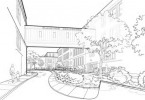Just 10 miles west of downtown Pittsburgh, 460 acres of forested land is being transformed into an outdoor botanic garden. The site is being rehabilitated to drastically reduce the effects of mine drainage and pollution left over from decades of surface and deep coal mining.
After extensive site-reclamation work and the clearing of mine hazards, Pittsburgh Botanic Garden has to date cultivated 60 acres of woodlands, meadows, and garden. Ongoing efforts continue to clean the area’s ground water and introduce a robust collection of plants to a now thriving forest.

Photo credit: Pittsburgh Botanic Gardens
The Garden opened to the public in 2015. Highlights include:
- The Woodlands, an area featuring thousands of native trees, shrubs and perennials planted since 2010. Three miles of trails, including one mile of ADA-accessible trails, take visitors through beautiful and serene woodlands. Play-and-discover stations dot the trails, beckoning children to the Storybook house and a giant bird nest. These stations encourage nature play and help develop the next generation of environmentalist.
- The Japanese Garden, including the Lotus Pond, a once blighted body of water that suffered from decades of abandoned coal mine pollution. Using a passive acid mine drainage filtration system, the Garden has restored life to the area, earning a Governor’s Award for Environmental Excellence in 2014. Now encircling this beautiful pond are dozens of newly planted cherry trees.
- The Pioneer Homestead features a 1784 log house, currently used as a classroom, and an 1870s barn with original wood siding and chestnut beams. The Heritage Apple Orchard produces apples, some of the same cultivars beloved by Thomas Jefferson, as heirloom chickens enliven the site.
Media Contact: Kevin Fernando, Marketing Associate | 412-444-4464, x231







